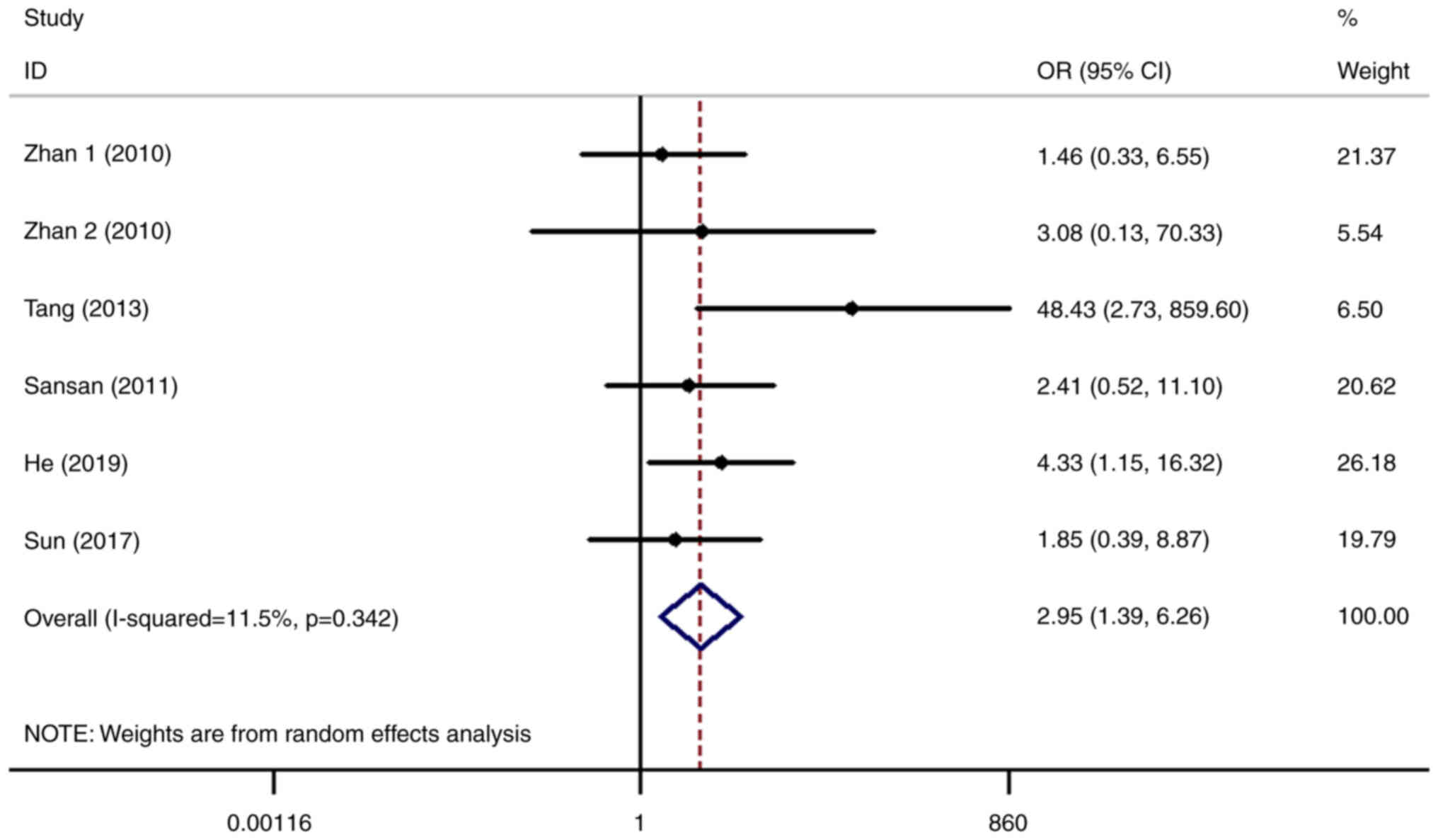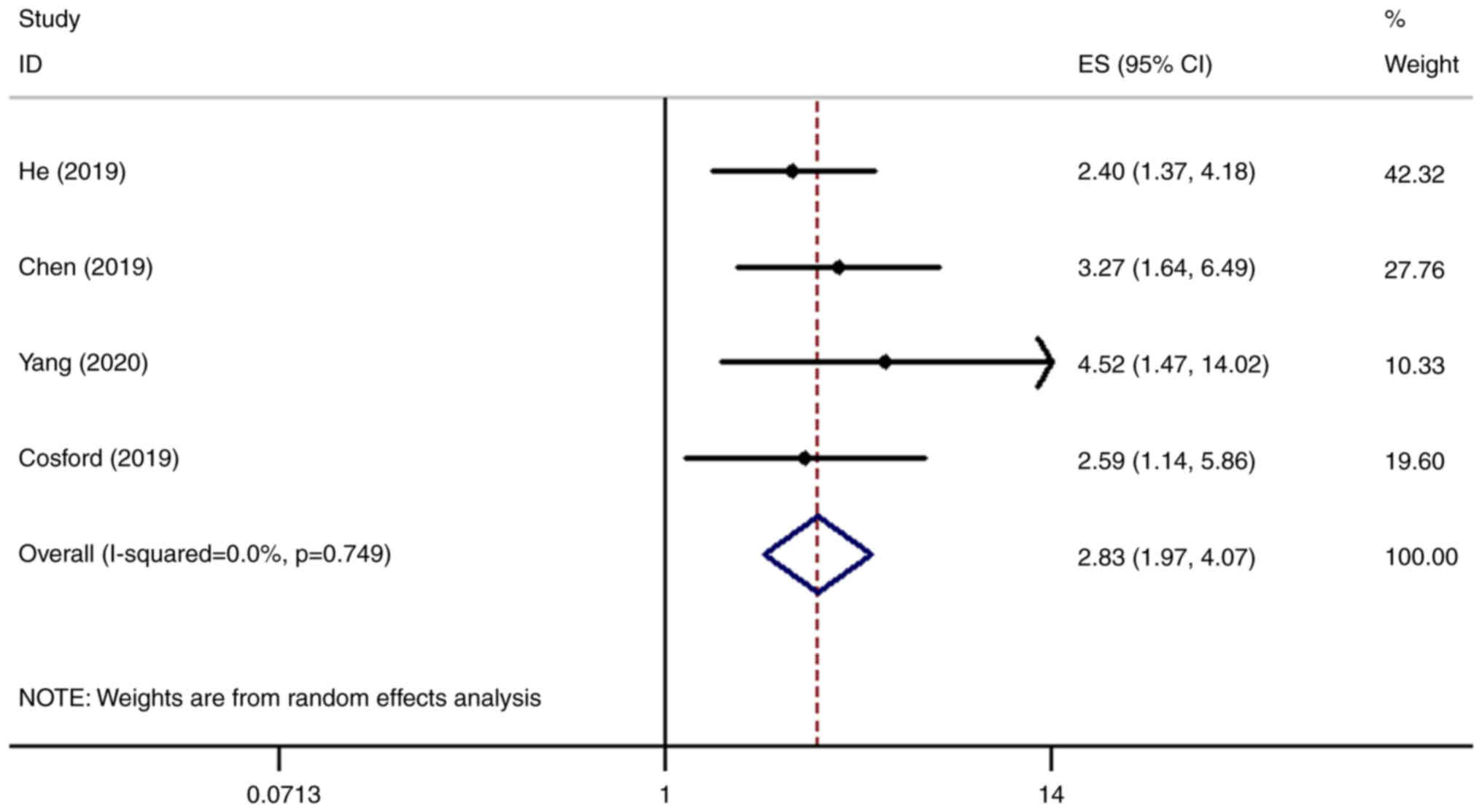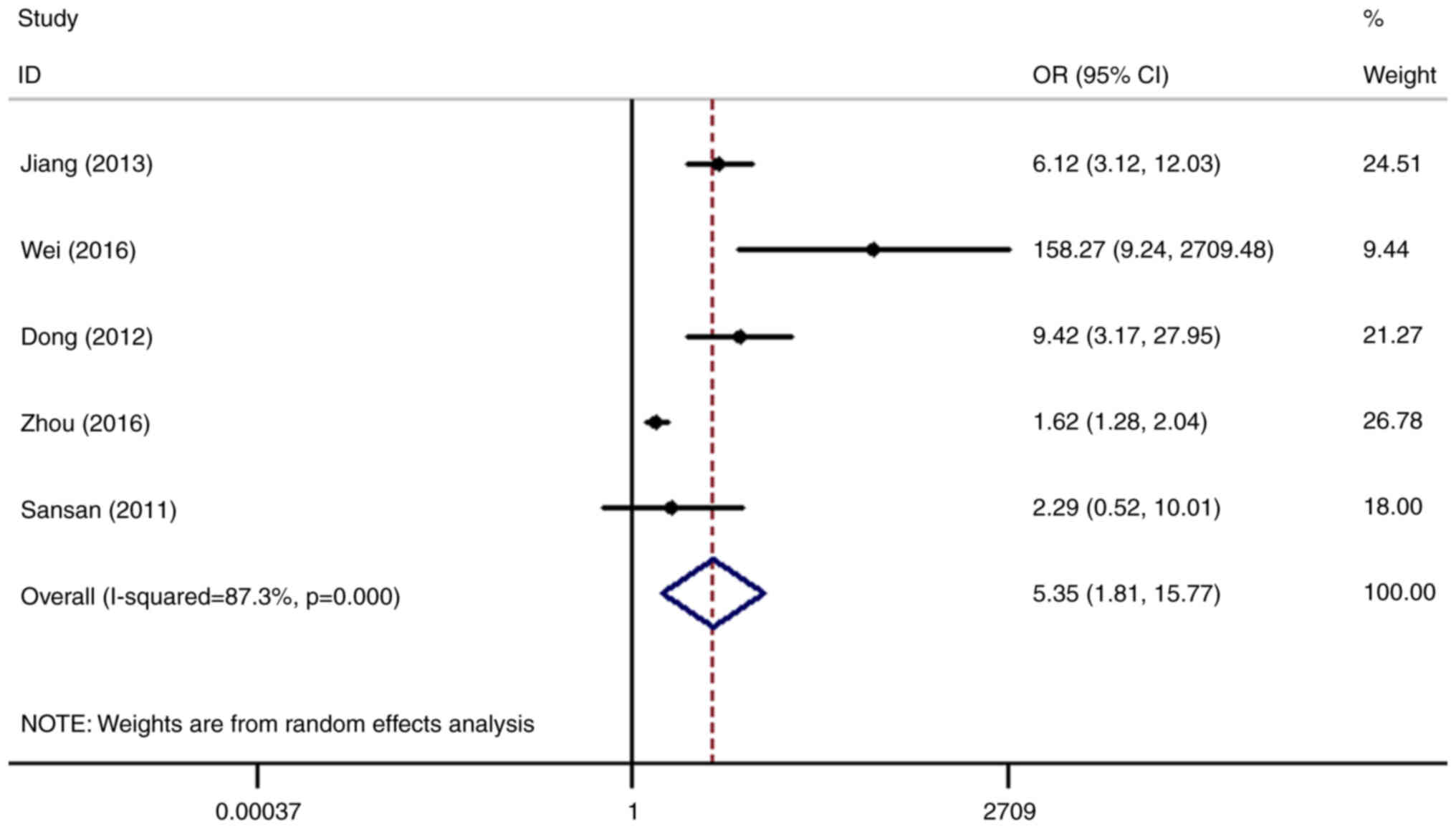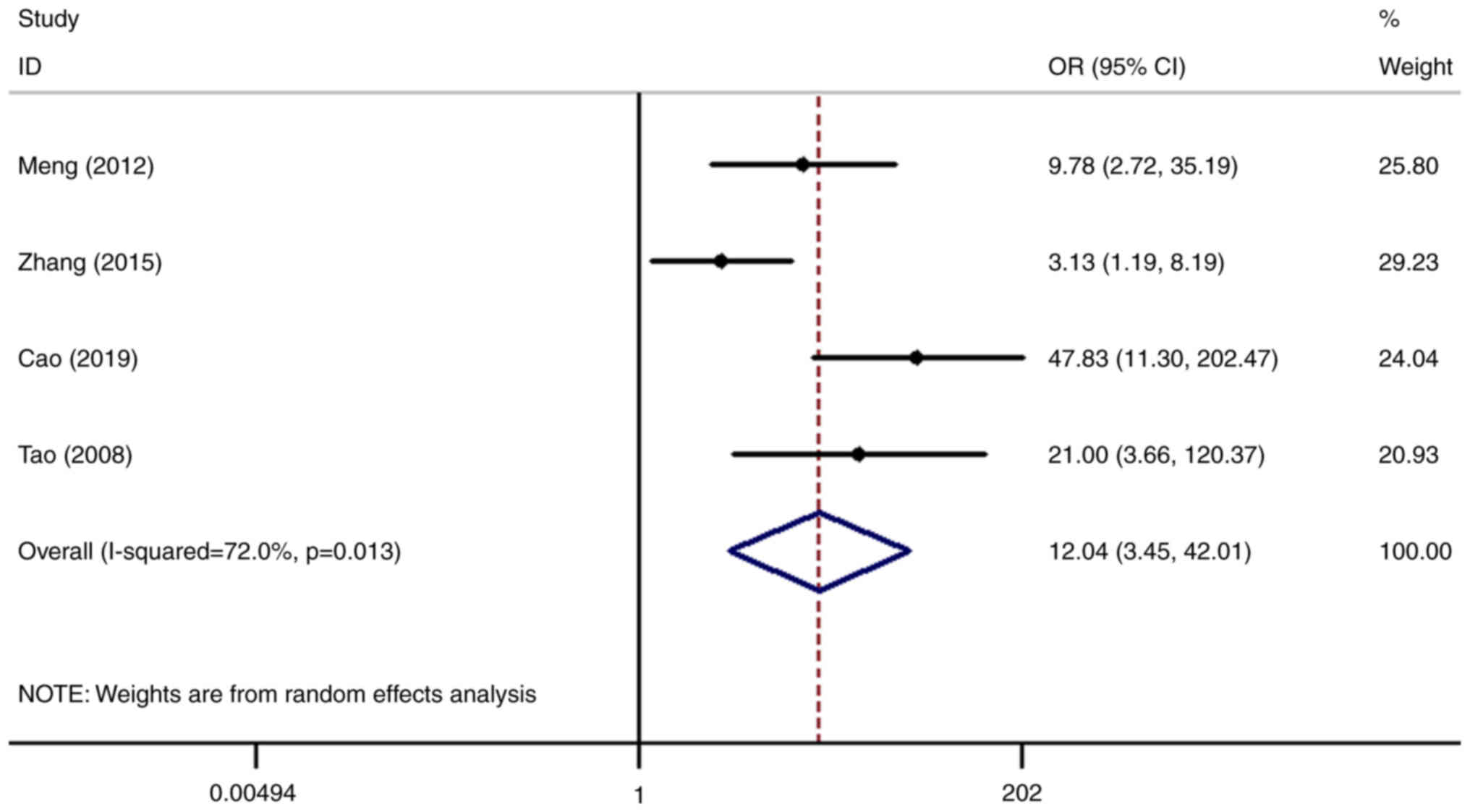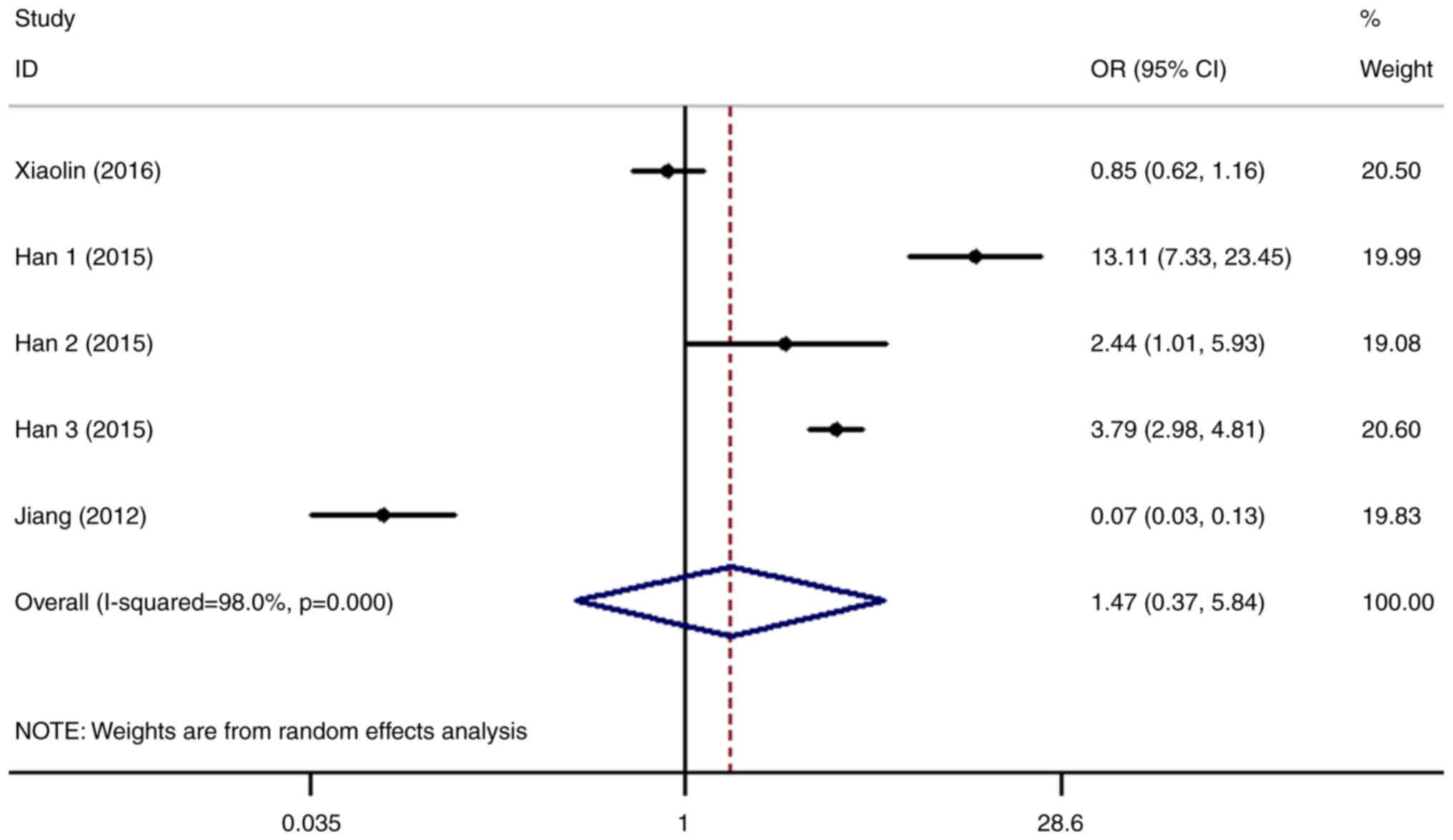Role of SHP2/PTPN11 in the occurrence and prognosis of cancer: A systematic review and meta‑analysis
- Authors:
- Published online on: November 22, 2022 https://doi.org/10.3892/ol.2022.13605
- Article Number: 19
-
Copyright: © Li et al. This is an open access article distributed under the terms of Creative Commons Attribution License.
Abstract
Introduction
Src homology-2 domain-containing protein tyrosine phosphatase (SHP2) is a member of the protein tyrosine phosphatase (PTP) family (1). Among them, SHP2/PTP non-receptor type 11 (PTPN11) is currently the only proto-oncogene in the PTP family to be confirmed and is expressed in a variety of human tissues (2).
SHP2/PTPN11 is expressed in numerous types of tissues, where it serves a regulatory role in cell signaling events important for an array of cellular processes, such as mitogenic activation, metabolic control, transcription regulation and cell migration (3). In a variety of types of cancer, aberrant activation of SHP2/PTPN11 has been previously documented to serve a significant pathogenic role. Wei (4) found that SHP2 is highly expressed in 60.78% (31/51) of gastric cancer tissues tested. In another study, Tang et al (5) demonstrated that SHP2/PTPN11 is significantly overexpressed in non-small cell lung cancer (NSCLC; 70%; 56/80) compared with that in adjacent normal tissues. In addition, Han et al (6) reported that SHP2/PTPN11 is significantly overexpressed in liver cancer tissues (78.36%; 105/134). However, Jiang et al (7) found that the expression levels of SHP2 are reduced in 70.6% patients with liver cancer, which were in turn associated with poorer prognosis.
Therefore, given the apparent close association between SHP2/PTPN11 and a number of human malignancies aforementioned, in addition to its presence in these malignant tissues (7,8), a comprehensive analysis of SHP2/PTPN11 would be of clinical significance. Therefore, the present study comprehensively explored the association between the expression levels of SHP2/PTPN11 and the risk of cancer.
Materials and methods
Article retrieval
In total, three major electronic databases, namely PubMed, China National Knowledge Infrastructure and Cochrane Library, were searched for the present study. The search terms used include the following: ‘Src homology 2 domain containing protein tyrosine phosphatase’ or ‘SHP2’ or ‘protein tyrosine phosphatase non-receptor type 11’ or ‘PTPN11’ and ‘Neoplasm*’ or ‘Cancer*’ or ‘tumor*’ or ‘carcinoma*’. The search deadline was May 2022.
Eligibility criteria
Studies were eligible for inclusion if they met the following criteria: i) The study having similar purposes and statistical methods with complete data; ii) the eligible study assessed the relationship between SHP2 or PTPN11 and risk of cancer; iii) the study had clear experimental grouping methods and SHP2 or PTPN11 detection methods; and iv) the nationality, race and age of all patients were not restricted. The language of the literature was not restricted.
By contrast, the study would be excluded if it met the following criteria: i) The study had incomplete information; ii) abstracts only and case reports; iii) animal studies, cellular studies, systematic reviews and other non-original studies; iv) the study did not have clear grouping methods and SHP2 or PTPN11 detection methods; and v) there was no control group.
Screening and data extraction
In total, two researchers independently read and screened the retrieved studies. If there were any dispute, then a third researcher would make a comprehensive judgment. EndNote X7 (Thomson Corporation) software was first used to automatically exclude any duplicate literature, before the researchers browsed all the remaining literature to manually remove further duplicated studies. Subsequently, studies that did not meet the inclusion criteria were excluded by reading their titles and abstracts. The remaining studies that did not meet the inclusion criteria was then also excluded by reading the full text, before relevant data were extracted from the studies (Fig. 1). The information extracted were as follows: i) The different detection methods may be used to detect the expression level of SHP2/PTPN11 in different studies. Therefore, in order to have comparable results, this meta-analysis used binary variables to extract data, and extracted the number of occurrence and non-occurrence in the experimental group and control group; ii) SHP2 or PTPN11 detection method; iii) study grouping method, iv) the name of the first author; v) the year of publication; vi) the geographical location of the patient; and vii) patient age.
Statistical methods
The Newcastle-Ottawa Scale (NOS) was used to independently evaluate the quality of articles that met the inclusion criteria. Each article was then assigned a quality score of ≤8 stars. Articles with a score of <5 represent low quality, whereas articles with a score of >6 were classified as high quality. Low-quality articles were subsequently excluded. Statistical analysis was performed using the STATA 12.0 software (StataCorp LLC). If there were ≥2 articles that examined the relationship between the expression of SHP2/PTPN11 and the risk of cancers, statistical analysis would then be performed. Otherwise, descriptive analyses would be performed instead. Heterogeneity among studies was assessed using the Chi-square test and I2 test. The random-effect model was used to pool the data. Begg and Egger tests would be used to assess any potential publication bias, with P<0.05 considered to indicate a statistically significant publication bias. In this manuscript, since there are larger quantity of studies on lung cancer, gastric cancer, cervical cancer and liver cancer, the Egger's linear regression model and Begg's funnel plot were used to test for publication bias. However, the number of studies investigating breast cancer, ovarian cancer, thyroid cancer, colorectal cancer, glioma, pancreatic cancer, nasopharyngeal cancer and prostate cancer was ≤2, rendering them not suitable for performing publication bias analysis. The pooled results were presented as the odds ratio (OR) and 95% CI. If OR >1 and P<0.05 were satisfied, this would indicate that SHP2/PTPN11 expression is statistically associated with the risk of cancer. P<0.05 was considered to indicate a statistically significant difference throughout.
Results
Characteristics of included literature
A total of 1,217 articles were retrieved. After excluding duplicated studies and filtering the studies using the aforementioned criteria, 128 studies remained. A total of 23 articles were found to explore the relationship between the expression levels of SHP2/PTPN11 and 12 types of cancer (Fig. 1; Table I).
Higher expression levels of SHP2/PTPN11 can increase the risk of NSCLC and reduce the overall survival (OS) of patients
The relationship between the expression level of SHP2/PTPN11 and the risk of lung cancer was analyzed in six datasets (5,8–11). After statistical analysis, it was found that the risk of lung cancer in patients with higher expression levels of SHP2/PTPN11 was 2.95-fold higher compared with that in the normal control group (OR=2.95, 95% CI=1.39-6.26; Fig. 2), with the difference of which being statistically significant (P=0.005). Following further stratified analysis, it was found that higher expression levels of SHP2/PTPN11 mainly increased the risk of NSCLC (OR=3.41, 95% CI=1.07-10.80; P=0.037; Fig. 2) but not small cell lung cancer (SCLC). However, this may also be due to the relatively few studies on the role of SHP2/PTPN11 in SCLC, resulting in false negative results. Therefore, further scientific and clinical research are required to investigate the relationship between SHP2/PTPN11 and SCLC.
The relationship between the expression levels of SHP2/PTPN11 and the OS of patients with NSCLC was analyzed in four datasets (8,12–14). It was found that the OS of patients with higher expression levels of SHP2/PTPN11 was significantly lower compared with that of the normal control group [hazards ratio (HR)=2.83, 95% CI=1.97-4.07; P<0.001; Fig. 3].
High expression levels of SHP2/PTPN11 increase the risk of gastric cancer and cervical cancer
The relationship between the expression levels of SHP2/PTPN11 and the risk of gastric cancer was analyzed in five datasets (4,10,15–17). The results showed that the risk of gastric cancer in patients with higher expression levels of SHP2/PTPN11 was 5.35-fold higher compared with that in the normal control group (OR=5.35, 95% CI=1.81-15.77), with the difference being statistically significant (P=0.002; Fig. 4).
Subsequently, the relationship between the expression levels of SHP2/PTPN11 and the risk of cervical cancer was analyzed in four datasets (3,18–20). The risk of cervical cancer in patients with high SHP2/PTPN11 expression was 12.04-fold higher compared with that in the normal control group (OR=12.04, 95% CI=3.45-42.01), with the difference found to be statistically significant (P<0.001; Fig. 5).
The relationship between the expression level of SHP2/PTPN11 and the risk of liver cancer was next analyzed in five datasets (6,7,21). The results revealed that the risk of liver cancer in patients with higher SHP2/PTPN11 expression levels was 1.47-fold higher compared with that in the normal control group (OR=1.47, 95% CI=0.37-5.84). However, the difference was not statistically significant (P=0.582; Fig. 6).
Relationship between SHP2/PTPN11 expression level and other types of cancer
In addition, it was also found that the higher expression levels of SHP2/PTPN11 in breast cancer (10,22), ovarian cancer (23,24) and pancreatic cancer (25) can promote the occurrence of tumors compared with that in normal tissues. By contrast, the expression levels of SHP2/PTPN11 in thyroid cancer (26,27), colorectal cancer (10), glioma (5), nasopharyngeal cancer (10) and prostate cancer (28) did not exhibit any statistically significant associations (Table II). However, for these malignancies, the quantity of relevant clinical information on the role of SHP2/PTPN11 remain insufficient. Therefore, additional research is required to explore the role of SHP2/PTPN11 in these types of cancer.
Publication bias assessment
Since there was a large quantity of studies on lung cancer, gastric cancer, cervical cancer and liver cancer, Egger's linear regression model and Begg's funnel plot were used to assess publication bias. However, the number of studies that assessed the association between SHP2/PTPN11 and breast cancer, ovarian cancer, thyroid cancer, colorectal cancer, glioma, pancreatic cancer, nasopharyngeal cancer and prostate cancer were ≤2, rendering them not suitable for performing publication bias analysis. The results revealed that there was no publication bias among the studies of lung cancer, gastric cancer, cervical cancer and liver cancer (P>0.05; Table III).
Discussion
PTP catalyzes the dephosphorylation of phosphotyrosine and is a key control mechanism in mammalian signal transduction (11). Aberrant expression levels of SHP2/PTPN11 have been reported to promote a number of diseases, including types of cancer, diabetes and autoimmune diseases (29). SHP2/PTPN11 is involved in the regulation of various signaling pathways, such as Ras/ERK, Janus kinase/STAT, PI3K/AKT and NF-κB. As a result, they can regulate a variety of physiological processes, such as cell proliferation, differentiation, cell cycle progression and migration (30–32).
SHP2/PTPN11 mutations or their altered expression levels has been demonstrated to lead to the development of leukemia and a number of solid tumors, such as lung adenocarcinoma, colon cancer, breast cancer, neuroblastoma and melanoma (33). For example, cBioPortal was used to analyze the rate of SHP2/PTPN11 mutations in lung cancer. The results showed that SHP2/PTPN11 had the highest mutation rate in lung adenocarcinoma (7%) (Fig. S1A) and lung squamous cell carcinoma (6%) (Fig. S1B), while the mutation rate in small cell lung cancer was lower, only 1.7% (Fig. S1C). Mutations in lung adenocarcinoma and squamous cell carcinoma are mainly high expression of mRNA (Fig. S1). At present, commonly mutated genes that have been used in clinical practice for lung cancer include EGFR, KRAS, BRAF, HER2, MET, ALK, ROS1, RET and NTRK. Mutations in EGFR, KRAS, BRAF, HER2, MET mainly occur in lung adenocarcinoma, whereas mutations in ALK, ROS1 and RET mainly occur in non-small cell lung cancer, and mutations in NTRK can occur across various pathological types of lung cancer (34,35). These observations suggested that SHP2/PTPN11 also can serve as an ideal target for cancer intervention (36).
In solid tumors, excessive activation of SHP2/PTPN11 has been reported to serve a vital pathogenic role. SHP2/PTPN11 was found to be highly expressed in 70% of NSCLC tissue samples compared with that in their corresponding normal lung tissue samples. In addition, the expression levels of SHP2/PTPN11 and HOOK1 in NSCLC are significantly positively correlated, such that the higher expression levels of SHP2/PTPN11 can significantly reduce the OS of patients with NSCLC (8). Previous reports also showed that SHP2/PTPN11 can regulate KRASG12C signaling and the tumor microenvironment (35,36). Indeed, KRASG12C inhibitors and programmed death-ligand 1 (PD-L1)/programmed cell death protein 1 (PD-1) blocking is main treatment method against lung cancer (37,38). In addition. these studies reveal that the expression level of SHP2/PTPN11 is increased in different KRAS mutant subtypes (37,38). Treatment with immune checkpoint inhibitors (ICI) tends to be more beneficial in patients with NSCLC with high expression levels of SHP2/PTPN11 (37,38). Therefore, high expression of SHP2/PTPN11 may increase the therapeutic effects of ICI in patients with NSCLC with certain KRAS genotypes, including KRASG12C (37,38). SHP2/PTPN11 expression in NSCLC is also positively correlated with that of PD-L1. PD-1 blockade by ICI may reduce the immunoreceptor tyrosine-based inhibitory motif (ITIM)/immunoreceptor tyrosine-based switch motif (ITSM) phosphorylation, downregulating SHP2 signaling. This may in turn alleviate the inhibitory effects of PD-1 on T cell activation, thereby promoting anti-tumor immune responses (37,38). Jiang et al (15) reveal that there is a significantly increased rate of SHP2/PTPN11-positive expression (74.6%) in gastric cancer compared with that in the normal mucosa, but find no correlation between Helicobacter pylori infection and the positive staining rate of SHP2/PTPN11 expression. By contrast, the role of SHP2/PTPN11 in liver cancer remains controversial. Jiang et al (7) proposed that SHP2/PTPN11 is a tumor suppressor in liver cancer. Compared with that in normal tissues (96.7%), the positive expression rate of SHP2/PTPN11 is significantly lower in liver cancer tissues (66.1%). In addition, lower expression levels of SHP2/PTPN11 were found to associate with longer OS time in patients. The present meta-analysis revealed that higher expression levels of SHP2/PTPN11 could increase the risk of NSCLC, gastric cancer and cervical cancer, whilst reducing the OS time of patients with NSCLC. However, there was no significant association between the expression of SHP2/PTPN11 and the risk of liver cancer. Therefore, further clinical studies are required to verify the role of SHP2/PTPN11 in liver cancer.
The present meta-analysis comprehensively analyzed the role of SHP2/PTPN11 in tumors. However, a number of limitations remain. In several malignancies, the quantity of studies for SHP2/PTPN11 is insufficient, resulting in the lack of conclusive evidence to explain the role of SHP2/PTPN11 in these particular tumors. In lung cancer, there remains a lack of clinical evidence on the association between the expression level of SHP2/PTPN11 and tumor prognosis. In addition, for all types of cancer assessed in the present study, <10 studies were included, rendering it difficult to conduct stratified analyses to explore the source of heterogeneity.
In conclusion, the present meta-analysis revealed that SHP2/PTPN11 is highly expressed in a number of tumors, including NSCLC, gastric cancer, cervical cancer, breast cancer, ovarian cancer and pancreatic cancer, where SHP2/PTPN11 is associated with tumorigenesis and prognosis. Furthermore, increased expression of SHP2/PTPN11 was found to increase the risk of lung cancer, gastric cancer and cervical cancer, where increased expression of SHP2/PTPN11 can reduce OS of patients with lung cancer.
Supplementary Material
Supporting Data
Acknowledgements
Not applicable.
Funding
Funding: No funding was received.
Availability of data and materials
The datasets used and/or analyzed during the current study are available from the corresponding author on reasonable request.
Authors' contributions
SL was responsible for conceiving the present study, data collection, statistical analysis, mapping, writing the original draft and reviewing and editing. XW was responsible for data collection. QL was responsible for literature screening and data collection. CL was responsible for conceiving the present study, writing, reviewing and editing. SL and CL confirm the authenticity of all the raw data. All authors read and approved the final manuscript.
Ethics approval and consent to participate
Not applicable.
Patient consent for publication
Not applicable.
Competing interests
The authors declare that they have no competing interests.
References
|
Wang Q, Zhao WC, Fu XQ and Zheng QC: Exploring the distinct binding and activation mechanisms for different CagA oncoproteins and SHP2 by molecular dynamics simulations. Molecules. 26:8372021. View Article : Google Scholar : PubMed/NCBI | |
|
Leung CON, Tong M, Chung KPS, Zhou L, Che N, Tang KH, Ding J, Lau EYT, Ng IOL, Ma S and Lee TKW: Overriding adaptive resistance to sorafenib through combination therapy with src homology 2 domain-containing phosphatase 2 blockade in hepatocellular carcinoma. Hepatology (Baltimore, Md). 72:155–168. 2020. View Article : Google Scholar : PubMed/NCBI | |
|
Cao M, Gao D, Zhang N, Duan Y and Wang Y, Mujtaba H and Wang Y: Shp2 expression is upregulated in cervical cancer, and Shp2 contributes to cell growth and migration and reduces sensitivity to cisplatin in cervical cancer cells. Pathol Res Pract. 215:1526212019. View Article : Google Scholar : PubMed/NCBI | |
|
Wei H, Dongjiang Q, Aman X, Xiao Y and Zhen L: Study on the Mechanism of Omeprazole Promoting Gastric Carcinogenesis in Mice. Anhui Medicine. 115:1054–1060. 2016. | |
|
Tang C, Luo D, Yang H, Wang Q, Zhang R, Liu G and Zhou X: Expression of SHP2 and related markers in non-small cell lung cancer: A tissue microarray study of 80 cases. Appl Immunohistochem Mol Morphol. 21:386–394. 2013. View Article : Google Scholar : PubMed/NCBI | |
|
Han T, Xiang DM, Sun W, Liu N, Sun HL, Wen W, Shen WF, Wang RY, Chen C, Wang X, et al: PTPN11/Shp2 overexpression enhances liver cancer progression and predicts poor prognosis of patients. J Hepatol. 63:651–660. 2015. View Article : Google Scholar : PubMed/NCBI | |
|
Jiang C, Hu F, Tai Y, Du J, Mao B, Yuan Z, Wang Y and Wei L: The tumor suppressor role of Src homology phosphotyrosine phosphatase 2 in hepatocellular carcinoma. J Cancer Res Clin Oncol. 138:637–646. 2012. View Article : Google Scholar : PubMed/NCBI | |
|
He L, Li Y, Huang X, Cheng H, Ke Y and Wang L: The prognostic significance of SHP2 and its binding protein Hook1 in non-small cell lung cancer. Onco Targets Ther. 12:5897–5906. 2019. View Article : Google Scholar : PubMed/NCBI | |
|
Zhan X, Dong H, Sun C, Liu L, Wang D and Wei Z: Expression and clinical significance of SHP2 in the tumor tissues of smokers with lung cancer. Zhongguo Fei Ai Za Zhi. 13:877–881. 2010.(In Chinese). PubMed/NCBI | |
|
Sansan Z and Yuehai K: Scaffold Protein Gab2 Signal Regulation and breast cancer. Chinese Journal of Biochemistry and Molecular Biology. 27:300–304. 2011. | |
|
Sun YJ, Zhuo ZL, Xian HP, Chen KZ, Yang F and Zhao XT: Shp2 regulates migratory behavior and response to EGFR-TKIs through ERK1/2 pathway activation in non-small cell lung cancer cells. Oncotarget. 8:91123–91133. 2017. View Article : Google Scholar : PubMed/NCBI | |
|
Chen MJ, Wang YC, Wu DW, Chen CY and Lee H: Association of nuclear localization of SHP2 and YAP1 with unfavorable prognosis in non-small cell lung cancer. Pathol Res Pract. 215:801–806. 2019. View Article : Google Scholar : PubMed/NCBI | |
|
Yang H, He L, Zhang Y, Li Y, Huang X, Li Y, Lou Y and Wang L: The clinicopathological and prognostic implications of tyrosine phosphatase SHP2 and ankyrin Hook1 gene expression in non- small cell lung cancer patients treated with gemcitabine plus platinum as first-line chemotherapy. Ann Palliat Med. 9:2943–2952. 2020. View Article : Google Scholar : PubMed/NCBI | |
|
Karachaliou N, Cardona AF, Bracht JWP, Aldeguer E, Drozdowskyj A, Fernandez-Bruno M, Chaib I, Berenguer J, Santarpia M, Ito M, et al: Integrin-linked kinase (ILK) and src homology 2 domain-containing phosphatase 2 (SHP2): Novel targets in EGFR-mutation positive non-small cell lung cancer (NSCLC). EBioMedicine. 39:207–214. 2019. View Article : Google Scholar : PubMed/NCBI | |
|
Jiang J, Jin MS, Kong F, Wang YP, Jia ZF, Cao DH, Ma HX, Suo J and Cao XY: Increased expression of tyrosine phosphatase SHP-2 in Helicobacter pylori-infected gastric cancer. World J Gastroenterol. 19:575–580. 2013. View Article : Google Scholar : PubMed/NCBI | |
|
Dong S, Li FQ, Zhang Q, Lv KZ, Yang HL, Gao Y and Yu JR: Expression and clinical significance of SHP2 in gastric cancer. J Int Med Res. 40:2083–2089. 2012. View Article : Google Scholar : PubMed/NCBI | |
|
Zhuo C, Shao M, Chen C, Lin C, Jiang D, Chen G, Tian H, Wang L, Li J and Lin X: Chemotherapy effectiveness and prognosis of gastric cancer influenced by PTPN11 polymorphisms. Cell Physiol Biochem. 39:1537–1552. 2016. View Article : Google Scholar : PubMed/NCBI | |
|
Meng F, Zhao X and Zhang S: SHP-2 phosphatase promotes cervical cancer cell proliferation through inhibiting interferon-β production. J Obstet Gynaecol Res. 39:272–279. 2012. View Article : Google Scholar : PubMed/NCBI | |
|
Zhang P, Yang B, Yao YY, Zhong LX, Chen XY, Kong QY, Wu ML, Li C, Li H and Liu J: PIAS3, SHP2 and SOCS3 expression patterns in cervical cancers: Relevance with activation and resveratrol-caused inactivation of STAT3 signaling. Gynecol Oncol. 139:529–535. 2015. View Article : Google Scholar : PubMed/NCBI | |
|
Tao XH, Shen JG, Pan WL, Dong YE, Meng Q, Honn KV and Jin R: Significance of SHP-1 and SHP-2 expression in human papillomavirus infected Condyloma acuminatum and cervical cancer. Pathol Oncol Res. 14:365–371. 2008. View Article : Google Scholar : PubMed/NCBI | |
|
Xiaolin L, Liao R, Hanley KL, Zhu HH, Malo KN, Hernandez C, Wei X, Varki NM, Alderson N, Chu C, et al: Dual Shp2 and pten deficiencies promote non-alcoholic steatohepatitis and genesis of liver tumor-initiating cells. Cell Rep. 17:2979–2993. 2016. View Article : Google Scholar : PubMed/NCBI | |
|
Lei Wang, Qin X, Wang X and Zhu F: Expression and clinical significance of Shp2 protein in breast cancer. Jilin Medical Journal. 32:7692–7694. 2010. | |
|
Hu Z, Li J, Gao Q, Wei S and Yang B: SHP2 overexpression enhances the invasion and metastasis of ovarian cancer in vitro and in vivo. Onco Targets Ther. 10:3881–3891. 2017. View Article : Google Scholar : PubMed/NCBI | |
|
Yajuan W, Wei G and Shan H: Effects of sufentanil on the proliferation and apoptosis of ovarian cancer cells regulated by LINC00668. Medical Journal of West China. 33:205–210. 2021. | |
|
Zheng J, Huang S, Huang Y, Song L, Yin Y, Kong W, Chen X and Ouyang X: Expression and prognosis value of SHP2 in patients with pancreatic ductal adenocarcinoma. Tumour Biol. 37:7853–7859. 2016. View Article : Google Scholar : PubMed/NCBI | |
|
Cao J, Huang YQ, Jiao S, Lan XB and Ge MH: Clinicopathological and prognostic significance of SHP2 and Hook1 expression in patients with thyroid carcinoma. Hum Pathol. 81:105–112. 2018. View Article : Google Scholar : PubMed/NCBI | |
|
Hu Z, Yang B, Li T and Li J: Thyroid cancer detection by ultrasound molecular imaging with SHP2-targeted perfluorocarbon nanoparticles. Contrast Media Mol Imaging. 2018:87108622018. View Article : Google Scholar : PubMed/NCBI | |
|
Zhang K, Zhao H, Ji Z, Zhang C, Zhou P, Wang L, Chen Q, Wang J, Zhang P, Chen Z, et al: Shp2 promotes metastasis of prostate cancer by attenuating the PAR3/PAR6/aPKC polarity protein complex and enhancing epithelial-to-mesenchymal transition. Oncogene. 35:1271–1282. 2016. View Article : Google Scholar : PubMed/NCBI | |
|
Tripathi RKP and Ayyannan SR: Emerging chemical scaffolds with potential SHP2 phosphatase inhibitory capabilities-A comprehensive review. Chem Biol Drug Des. 97:721–73. 2021. View Article : Google Scholar : PubMed/NCBI | |
|
Liotti F, Kumar N, Prevete N, Marotta M, Sorriento D, Ieranò C, Ronchi A, Marino FZ, Moretti S, Colella R, et al: PD-1 blockade delays tumor growth by inhibiting an intrinsic SHP2/Ras/MAPK signalling in thyroid cancer cells. J Exp Clin Cancer Res. 40:222021. View Article : Google Scholar : PubMed/NCBI | |
|
Costigan DC and Dong F: The extended spectrum of RAS-MAPK pathway mutations in colorectal cancer. Genes Chromosomes Cancer. 59:152–159. 2020. View Article : Google Scholar : PubMed/NCBI | |
|
Song Z, Wang M, Ge Y, Chen XP, Xu Z, Sun Y and Xiong XF: Tyrosine phosphatase SHP2 inhibitors in tumor-targeted therapies. Acta Pharm Sin B. 11:13–29. 2021. View Article : Google Scholar : PubMed/NCBI | |
|
Yuan X, Bu H, Zhou J, Yang CY and Zhang H: Recent advances of SHP2 inhibitors in cancer therapy: Current development and clinical application. J Med Chem. 63:11368–11396. 2020. View Article : Google Scholar : PubMed/NCBI | |
|
Jiao XD, Qin BD, You P, Cai J and Zang YS: The prognostic value of TP53 and its correlation with EGFR mutation in advanced non-small cell lung cancer, an analysis based on cBioPortal data base. Lung Cancer. 123:70–75. 2018. View Article : Google Scholar : PubMed/NCBI | |
|
Román M, Baraibar I, López I, Nadal E, Rolfo C, Vicent S and Gil-Bazo I: KRAS oncogene in non-small cell lung cancer: Clinical perspectives on the treatment of an old target. Mol Cancer. 17:332018. View Article : Google Scholar : PubMed/NCBI | |
|
Jiawei Z, Yufang H, Li S and Xuenong O: The expression and clinical significance of SHP2 and PDL1 in pancreatic ductal adenocarcinoma. J Mudanjiang Medical College. 42:55–58. 2021. | |
|
Fedele C, Li S, Teng KW, Foster CJR, Peng D, Ran H, Mita P, Geer MJ, Hattori T, Koide A, et al: SHP2 inhibition diminishes KRASG12C cycling and promotes tumor microenvironment remodeling. J Exp Med. 218:e202014142021. View Article : Google Scholar : PubMed/NCBI | |
|
Feng HB, Chen Y, Xie Z, Jiang J, Zhong YM, Guo WB, Yan WQ, Lv ZY, Lu DX, Liang HL, et al: High SHP2 expression determines the efficacy of PD-1/PD-L1 inhibitors in advanced KRAS mutant non-small cell lung cancer. Thorac Cancer. 12:2564–2573. 2021. View Article : Google Scholar : PubMed/NCBI |




